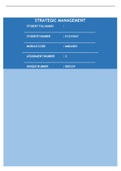Samenvatting
Summary literature Analysis of Governmental Policy (AM_470571)
- Instelling
- Vrije Universiteit Amsterdam (VU)
- Boek
- Making Health Policy
This is a summary of all the mandatory literature for the course Analysis of Governmental Policy that is necessary to make the exam and for the assignment.
[Meer zien]














